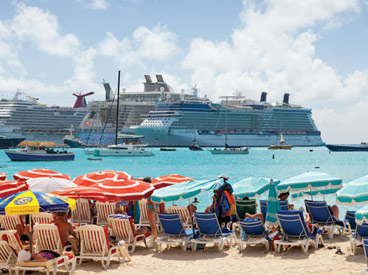That onboard revenue translates, roughly, into at least 24 percent of all cruise revenue. Along the U.S.-Caribbean routes it can jump to more than 30 percent, according to the U.N. World Tourism Organization. Booze is one of the biggest earners. Drinks are at least as expensive as they are on land. And ships are designed to encourage drinking, scattering bars and serving stations throughout, as Bob Dickinson, formerly of Carnival, explains: “In a well-executed ship design, the most convenient way to go from your cabin to the dining room should take you past a lounge. And because most ships sail in warm waters, you also need a highly visible bar by the pool — or even in it!”
Gambling brings in nearly as much profit. Spas, Internet fees, extra costs for fancier restaurants, fees for sports and exercise classes, photographs and a DVD of the cruise — that DVD can earn at least $100,000 in revenue on a short cruise — and souvenirs all bring in money. As Dickinson wrote, “Everyone has already prepaid for their ticket and the only variable left that will determine the overall revenue (and ultimately the overall profitability) of a voyage is how much is spent on board.
“The truth is that selling goes on all of the time all over the ship,” he said, “and it makes all the difference in the world when it comes to the bottom line.”
Convincing passengers to spend is part of the theater of a cruise, conjuring up “the vacation of a lifetime” with unique flashy shows. Passengers feel free to try things they rarely do at home — like attend an art auction. They trust the cruise line, they feel they can let their hair down and splurge. This helps explain how Carnival Cruise Lines could report $13 billion in revenue in 2009 during the Great Recession.
Not surprisingly industry spokesmen don’t extol cruise vacations as a chance to shop until you drop. More common is this description by Terry Dale, the former president and CEO of the Cruise Lines International Association, the trade group, who told me in a telephone interview that “we have passengers, customers who have wanderlust and a desire to see and experience. That is part of what we’re providing them — intellectual and spiritual enrichment.”
At first glance, another profit center for onboard revenue seems counterintuitive. Cruise lines make significant money from what the passengers do when they leave the ship and go ashore. On average, the cruise lines collect a commission or fee from the local tour agency as great as 50 percent of the price of the tour. In one year, Royal Caribbean earned a third of its profits from selling shore excursions.
Excursion might be a misnomer. They are designed by the hour. On a Caribbean stop, you can choose to take a bus tour of an island’s beaches and historic sites or go snorkeling near coral reefs. At ports near cities like Florence and Rome, the passengers are bused to the cities for a visit to a museum or a walking tour, always with great guides and time to eat and shop before returning to the ship.
This is a complete reversal of the original idea of the passenger liners, when the voyage itself was the excursion. Then ships docked for days at a time; a cruise was truly a rare, once-in-a-lifetime occasion and passengers expected to spend far more time on land, exploring.
The advantage of these excursions, said Adam Goldstein of Royal Caribbean, was that cruise ships allow tourists to visit so many cities in such a short time, albeit for mostly half-day stops.
“On a cruise ship you can see Tallinn, Estonia, and two days and a night in St. Petersburg, and you can see Helsinki and Oslo,” he said, describing a seven- or 12-day cruise. “It’s really not feasible to do that many flights in a two-week period.”
This is true and many tourists find a day in Tallinn and another in Oslo more than enough. However, the people of Tallinn and Oslo are having second thoughts about seeing hordes of people descending on their cities at once. Thousands of cruise passengers herded into a few well-known waterfronts or museums do earn bragging rights about seeing the windmills of Mykonos or the Hermitage in St. Petersburg. The regular appearance of these crowds is transforming the cities and ports, helping push out locals and alter the culture and sense of place that drew tourists in the first place.
“Cruise ships have changed the face of tourism in the last 10 years, and not for the better,” said Paul Bennett, founder and head of Context Travel in Philadelphia. “They’re like portable low-rent Hiltons that go everywhere with little concern for the garbage they leave behind or the havoc they make in the short time they invade a place. See Rome — the Vatican and the Coliseum — in a few hours and then take a bus back to the ship. We call it ‘drive-by tourism.’”
In between these ports of call, garbage left behind by cruise ships is polluting the ocean. According to the Environmental Protection Agency, in the course of one day the average cruise ship produces: 21,000 gallons of human sewage; one ton of solid waste garbage; 170,000 gallons of wastewater from showers, sinks, and laundry; 6,400 gallons of oily bilge water from the massive engines; 25 pounds of batteries, fluorescent lights, medical wastes and expired chemicals; and 8,500 plastic bottles.
Multiply this by those 400 ships cruising year-round, and you have a sense of the magnitude of the problem. But there are no accurate studies of how well that waste is disposed of because the ships are not required to follow any state or national laws once in international waters.
Become a Saturday Evening Post member and enjoy unlimited access. Subscribe now



